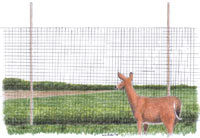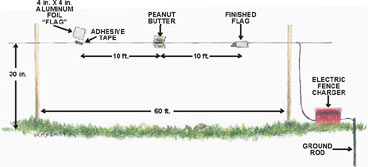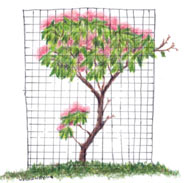Exclusion Methods
Exclusion methods prevent deer from accessing plants. Some methods reduce or eliminate deer damage. Exclusion methods include non-electric and electric fencing, and individual plant protection. For exclusion to be effective, the barriers must be properly installed and maintained, and must deny deer entry. Exclusion is considered to be one of the most effective method to reduce deer damage, and when installed and maintained properly, can eliminate deer damage. Installation and maintenance of exclusion methods are additional costs that should be evaluated when considering exclusion as an option. Exclusion can be cost-effective over the long term, depending on the size of the area being treated and the value protected plants. However, the unattractive appearance of some exclusion methods may preclude their use on landscaping plants.
Fencing
 Fencing is the most reliable way to exclude deer from an area. It can last for many years, but requires occasional maintenance. Fencing should be considered for high value plantings that require year-round protection. For example orchards, landscape and tree nurseries, vineyards, and other high value plants require perennial protection. Fencing can be a practical, and cost-effective method for protecting small landscapes, gardens and small orchards, and for large areas of high value crops. Because of the high cost, fencing is not a practical option for protecting large areas of crops of low value. Many different styles of fencing exist and specific information on fencing can be obtained from your local Cooperative Extension Service or Farm Service Agency.
Fencing is the most reliable way to exclude deer from an area. It can last for many years, but requires occasional maintenance. Fencing should be considered for high value plantings that require year-round protection. For example orchards, landscape and tree nurseries, vineyards, and other high value plants require perennial protection. Fencing can be a practical, and cost-effective method for protecting small landscapes, gardens and small orchards, and for large areas of high value crops. Because of the high cost, fencing is not a practical option for protecting large areas of crops of low value. Many different styles of fencing exist and specific information on fencing can be obtained from your local Cooperative Extension Service or Farm Service Agency.
Fencing can be costly to erect, and may require maintenance to remain effective, but it can be the most effective deterrent to deer damage. Gates, posts, and hardware are additional materials that may be needed, which will add to the cost of fencing an area. Installation and maintenance costs should also be considered before deciding on fencing as a deer damage deterrent.
Permanent fences can last for 30 years or longer, which can be particularly important when protecting perennial crops such as orchards, vineyards, landscape and tree nurseries and forest plantations. Temporary fencing is less expensive than permanent fencing, and can be useful in protecting plants for short periods of time, such as truck crops, gardens and flowers prior to harvest.
Eight-foot and taller fences are recommended to exclude deer, as shorter fences may not exclude all deer. Fences need to be properly anchored to the ground, and should conform to the ground contour to prevent deer from going under them. Fencing may need to be marked and made more visible to prevent deer from contacting and getting tangled in it, which could damage the fence and injure deer. Where fencing is erected across known deer travel paths, flagging should be used to alert the deer of its presence. Brightly colored flagging, attached at waist height in three-foot intervals along the fence, can be used to make the fence more visible, which can help deer avoid contact with the fence.
When possible, fencing should be erected prior to deer damage to prevent deer from establishing feeding patterns. Deer can be very persistent once they’ve established a feeding pattern, which can make excluding them very difficult.
Habitat modifications, like vegetation removal and control, may be required to maintain some of the types of fencing mentioned here. For example, it may be necessary to remove vegetation around and beneath an electric fence to prevent it from grounding the fence. It may be necessary to remove shrubs along a field edge, to prevent deer from accidentally running into and damaging a fence. Fence maintenance should include regular vegetation control using a line trimmer or with the application of an herbicide. Fences erected in wooded areas may require repair when limbs or trees fall on the fence. It may be prudent to remove limbs or trees that may potentially fall on the fence and cause damage.
Some community restrictions may restrict or prevent the use of certain kinds of fencing, so it is best to check local ordinances before considering fencing as an option. With a concerted effort, communities may be able to get local fencing ordinances changed to allow some types of deer-proof fencing. For example, the Montgomery County Council recently changed their fencing ordinance to allow certain types of fencing in their communities to deter deer and deer damage.
Non-Electric Fencing
Wire Fencing
Woven wire fencing is constructed of metal wires woven together to form a physical barrier. Woven wire fencing in eight foot or taller heights, is considered the best permanent fencing to exclude deer, and should be considered where deer damage is moderate to high. It can last for up to 30 years, needs relatively little maintenance, and comes in a variety of different styles and heights.
Woven wire fencing is highly resistant to damage because it is very flexible. It is expensive to purchase and install, but can be a cost effective remedy to protect valuable plantings. Because of its high cost, woven wire fencing should only be considered for high-value plantings that require permanent or perennial protection.
Woven wire fencing has been used successfully to exclude deer from agricultural crops, orchards, and tree and landscape nurseries. It is also used to exclude deer from roadways and airports where they may cause accidents. Chain-link fencing is a well-known type of woven wire fencing, though there are other types of woven wire fencing that adequately exclude deer. High-Tensile Fixed-Knot fencing is a less expensive alternative to chain-link fencing that excludes deer equally well.
Plastic Deer Fencing
Polypropylene or plastic deer fencing is a heavy plastic mesh that can be used to exclude deer in areas where damage pressure is light to moderate. It can be used to prevent deer damage to gardens, landscaping, some crops and individual plants. It is more flexible than steel wire mesh and readily follows the ground contour.
Because it is flexible, polypropylene mesh may sag, and the manufacturer recommends that a cable be strung through the top of the fence to support it between posts. The mesh should be supported by posts spaced 3-4.5 yards apart, and can be fastened to poles using self-locking plastic ties. In wooded areas, fencing staples can be used to attach plastic fencing to trees.
Like other forms of fencing, polypropylene deer fencing must be properly anchored to the ground to adequately exclude deer. Stakes must be used to anchor the bottom of the fence, to prevent deer from crawling under it. Repair of the fence can be easily done using plastic self-locking ties to mend tears or by patching any holes with another section of mesh material.
There are two kinds of plastic mesh deer control fencing available, standard and heavy duty. Tenax C-Flex, and Deer-X Netting are two commercially available brands of this plastic fencing that are available from retailers.
Polypropylene fencing is generally less expensive than other types of fencing, is easier to install and repair, and blends easily with shaded and wooded areas. Some people find plastic fencing to be more attractive than wire fencing, because it is less visible.
Some community covenants may prohibit some types of fencing, but may allow polypropylene fencing. Polypropylene fencing is short-lived, when compared to wire fencing, and may last for up to 10 years, according to some manufacturer claims. Posts, hardware and tools will add to the cost of this type of fencing.
Electric Fencing
Electric fencing was developed to contain livestock and to exclude wildlife. It is designed to administer an electric shock to animals that come into contact with the fence. The shock deters the animal from entering the fenced area, and prevents them from crossing it. Deer are aversively conditioned by their contact with the fence, and they learn to avoid fenced areas. This aversion can keep deer away and help protect plantings.
Electric fencing is less expensive than woven wire fencing. It can be an effective and cost-efficient deterrent that can reduce deer damage considerably. Electric fencing can last up to 30 years.
Basic electric fencing consists of wires that conduct an electric charge, supported by wooden, metal or plastic posts, and a charging system that supplies an electric current to the fence wires. Some or all of the wires of an electric fence conduct an electric current that emits a shock when touched. Animals must be grounded to get a shock, and must touch either a ground wire or a charged wire simultaneously, or they must touch a charged wire and the ground which has been grounded with a grounding rod.
The cost for electric fencing can vary widely depending on the style of fencing used, and the size of the area that needs protected. Vegetation control may be necessary to prevent grounding of the fence. Regular fence maintenance should address this problem by keeping vegetation controlled using a line trimmer or with the application of an herbicide.
Electric fence designs vary from simple to complicated. Simple electric fence designs can be used to deter deer damage where deer numbers are low to moderate, and other food sources are available to deer. An example of a simple electric fence design is the single strand electric fence. A single-strand electrified fence can decrease deer damage where feeding pressure is light. A baited single strand deer fence can also be an effective, and affordable, temporary protection for a garden or landscaping, particularly when there is other food available for deer to eat, outside of the fence.
Complicated fence designs consist of multiple wires configured into designs that encourage deer to touch the fence wires and receive a shock. They are more effective at excluding persistent deer, and some have been reported to exclude up to 80% of deer that attempted to cross them. Complicated electric fence designs are more costly, but can be more effective at deterring deer damage. They should be considered where deer numbers are high, deer damage pressure is high, and the value of the plantings is moderate to high.
Electric fencing should not be considered for use in residential areas, but can be used in most rural areas. Electric fencing is an alternative that can be effective at reducing deer damage to some landscape and garden plantings. Electric fences should be marked with warning signs to prevent humans from coming into contact with the fence. The wires of electric fences should be smooth and charged using a commercially available fence charger because the shock they administer is intermittent which is safe to humans and animals. Direct current and barbed wire should never be used for electric fences because their potential use may cause electrocution.
Some styles of electric fencing were designed to exclude cattle and have been modified to exclude deer. Other styles of electric fencing have been designed specifically to exclude deer. Vertical electric fencing, overhanging, slanted or sloping electric fencing, and some combination fences encourage deer to attempt to crawl through the fence, causing them to contact the charged wires, and administering a shock. Deer usually learn to avoid fenced areas after being shocked. Proper installation and maintenance of an electric fence can ensure that the fence provides sufficient shock to deter deer. Different styles of electric fencing exist, and specific information on various kinds of electric fencing is available from your local Cooperative Extension Service or Farm Service Agency.
Polytape, Polywire, and Electrobraid fences have wires made of brightly colored materials such as plastic ribbon or cord with thin metal wires woven into them, which conduct electricity like ordinary electric fence wire. The wires of these fences are brightly colored and highly visible, and are more likely to be detected and contacted by deer. High visibility can increase the chances that deer will contact the charged wires, making them more effective than regular fence wire. These fences can also be baited with an attractant along their entire length which can make nose to fence contact by deer more likely.

Baited electric deer fences can be affordable and furnish temporary protection for some crops, gardens, landscaping, and small orchards. Single or multiple wires can be used with this style of fence. A single strand baited electric fencecan be effective at deterring deer where the damage pressure is light to moderate. The baited electric fence uses a simple electric fence, baited with an attractant that encourages deer to touch the charged wire of the fence. Baited deer fences rely on an attractant that encourages a deer to contact the charged fence with its nose or mouth. The charged wires should be suspended at heights where deer will easily make contact with them - two to three feet off the ground. The electric shock the deer receives conditions the deer to avoid the area. Unless it is kept baited, the effectiveness of an electric fence will decrease, as deer will learn to go through, over or under the charged wires. Once deer have tasted the crop inside the fence, keeping the deer out can be very difficult. This system is most effective when the fence is erected prior to any deer damage.
A variety of baits can be used to attract deer to touch an electric fence wire. Several commercial attractants are available from retailers, though homemade attractants are cheaper and also work well. A common homemade attractant consists of a mixture of vegetable oil and peanut butter mixed in a 1:1 ratio. It is an excellent homemade attractant that will encourage deer to touch the fence wire. Baits can be applied directly to Polytape, Polywire, or to 4 by 4 inch foil flags attached to the charged wire. Baits should be attached at 30 foot intervals along the fence, and should be replenished every three weeks or more often depending on the weather.
Electric fences have some limitations that should be considered. Snow cover on the ground can prevent deer from finding other foods. Lack of food can encourage deer to tolerate the shock if they are hungry enough, and there is food behind the fence. Deer may tolerate an electric shock if the only available food is behind the fence, the shock is insufficient, or deer numbers are high and competition for food is high. Deer may even learn to avoid receiving a shock if they jump through the fence wires without touching a ground.
The effectiveness of any electric fence can decrease if deer learn to go through, over or under the charged wires, or if they learn that the cost of the shock is worth the reward of food that is behind the fence. Snow and vegetation can ground electric fences, which can interrupt the electric current, and can render them ineffective at deterring deer. But, deer will tolerate the shock if they are hungry enough and there is a lack of other foods outside the fenced area.
Individual Plant Protection
Tree Shelters, Wire Cages and Plastic Netting
Tree shelters, wire cages, and plastic netting erected around individual plants can exclude deer, and can prevent them from causing browse damage and bark stripping. Bark stripping is done in the fall of the year, when a buck rubs it’s antlers against trees. Tree shelters can prevent antler rub damage, and can protect young trees from browse damage until the tree outgrows the height of the tree shelter.
Wire cages four feet tall and one and one-half feet in diameter can be erected around individual plants and can prevent browsing and antler rubbing damage by deer. Tree shelters and wire cages may be considered unattractive and are not preferred where the aesthetics of a planting cannot be compromised.
Rigid, plastic netting is another material that can be used to exclude deer and can reduce deer damage to some plantings. Plastic netting can provide temporary protection for seasonally harvested berries, fruit and some flowers. Netting typically works best in areas with light deer feeding pressure. Wooden stakes and self-locking ties can be used to anchor the netting over individual plants and to protect groups of plants. Bird netting (which is more flexible) is not recommended due to its tendency to entrap wildlife like skinks and snakes.
Polypropylene fencing, netting, and repellents should be considered where aesthetic considerations limit the use of visually obstructive exclusion materials like woven or welded wire.